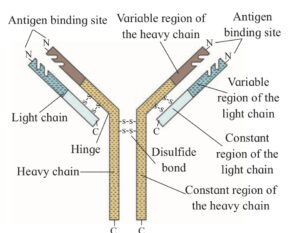Antibodies, or Immunoglobulins (Igs), are glycoproteins with remarkable specificity towards particular antigens. They are generated in response to antigenic stimulation and produced by plasma cells, which originate from B–lymphocytes. These mature plasma cells exhibit an extraordinary production rate, synthesizing antibodies at approximately 2000 molecules per second.
Structure of antibody:
1. Antibodies, or immunoglobulins (Igs), are glycoproteins highly specialized to antigens.
2. Their structure resembles a ‘Y,’ crafted from four polypeptide chains – two heavy (H) chains and two light (L) chains.
3. Disulfide bonds unite the polypeptide chains, shaping the distinctive ‘Y’ structure.
4. The hinge region links the arms and stem of the antibody.
5. Each antibody chain boasts two segments – the variable region and the constant region.
6. The variable region, also known as the paratope, plays a vital role in recognizing and binding to specific antigens, forming an antigen-antibody complex.
